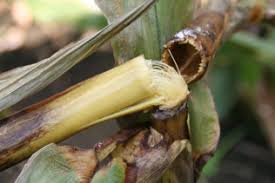The Bacterial Stem rot (Pectobacterium Carotovorum) affects crops like sweet pepper and Tomato. It is a bacterium which attacks fruits and stem. It survives in crop debris and can be spread by water.
Formerly known as Erwinia carotovora subsp. carotovora has recently been renamed Pectobacterium carotovora. It is one of the pectolytic bacteria causing extensive bacterial rots (bacterial soft rot, bacterial stem rot).
Pectobacterium carotovorum is a bacterium of the family Pectobacteriaceae; it used to be a member of the genus Erwinia. The species is a plant pathogen with a diverse host range, including many agriculturally and scientifically important plant species.
Stem rot on tomatoes for instance is usually caused by a species of bacteria called Pectobacterium carotovorum or by Erwinia carotovora subsp. carotovora. It is most often found on staked/trellised tomatoes due to stems being damaged by rubbing on ties or stakes. It is also found in tomatoes that have been pruned.
Bacterial stem rot infection starts to develop from petiole infection. Bacterial stalk rot is caused by a bacterial pathogen called Pectobacterium spp. The bacteria survive in the plant debris and in soil. Infection of the stem leads to the rotting of the pith.
The bacteria usually only infects plants that have been damaged as it enters the system through cuts and abrasions.
Bacterial stem rot affects mostly nightshade vegetables. A fungal disease also called stem rot, affects a wide variety of edible and ornamental plants.
Read Also: Gray Leaf Spot (Stemphylium spp) – Symptoms and Damage Control
Symptoms and Damage of Bacterial Stem Rot (Pectobacterium Carotovorum)

The internal part of the stem rot and grows hollow. Plants turn yellow and start wilting. Large black stripes appear on stems.
On fruit, slimy, viscous moisture rot can appear. On the fruits, lesions first are small and sunken, water-soaked and light to dark brown. They are adjacent to wounds and natural openings at the stem end. Later the fruit becomes soft and lesion contents become liquid.
In tomato, Erwinia carotovora subsp. carotovora or Pectobacterium carovora causes bacterial stem rot as well as soft rot. Stem rot is first noticed when plants wilt at the time of first harvest or after that.
The pith disintegrates and the stem becomes hollow. Because of the bacterial growth in the pith, the stem seems wet and slimy. Above or below the hollow stem the vascular tissue keeps its normal colour.
The initial symptom, wilting of the whole plant, is usually noticed when the first lot of fruit is ripe and ready for harvest. The wilting is caused by the pith (centre of the stem) disintegrating.
This disease is similar to pith necrosis in that respect. Unlike pith necrosis however, the outside of the stem will also become wet and slimy if a tomato plant is infected with stem rot. Sometimes, in severe cases, plant extremities may also turn black and drop off.
Read Also: Anatomy of Fishes: Female Fish and their Reproductive Strategies
How to prevent Bacterial soft rot, bacterial stem rot

An effective treatment has not yet been identified. If you catch it early however, you may be able to prune off affected areas to prevent spread to the rest of the plant.
If you do this, disinfect the cut with an infusion of garlic or chives in water. The success of this method is variable.
Some of the damage prevention measures include the following:
- Use healthy seeds.
- Remove all contaminated plants.
- Grow on well drained and aerated soils.
- Avoid overhead watering
- Avoid working on wet plants.
- Weed field on a regular basis.
- Avoid to bring too much nitrogen to the field.
- Favor staked plants.
- Prevent high humidity
- Use sanitation to prevent spread within the crop
- Clean tools and equipment
- Promote rapid closing of wounds
- Disinfest recirculating irrigation water
- Prevent plant diseases by optimizing plant potential and crop resilience.
The best way to prevent this disease is to tie plants loosely to stakes with soft ties that won’t rub on the stems. I would also recommend not pruning your tomato plants.
If you must prune plants (those gardening in very humid climates who grow very bushy tomatoes may need to do some light pruning to improve air circulation but in almost all cases, if plants are adequately spaced, pruning is unnecessary) always disinfect your secateurs in between each cut and, in particular, in between plants.
A dilute bleach solution is suitable as is a solution of (or even straight) eucalyptus oil. Always make sure your plants are healthy as well. If plants are suffering from nutrient or water deficiencies (or too much water) then they will be much more likely to succumb to disease if you prune them or they become damaged as a result of being staked or trellised.
Read Also: Cercospora Leaf Spot – Symptoms and Damage Prevention
Frequently Asked Questions
We will update this section soon.

